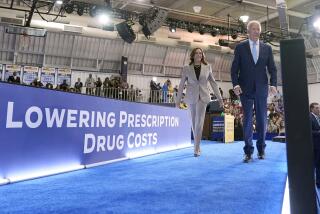Seniors ache as premiums soar
- Share via
WASHINGTON — As if escalating prices for food and gas weren’t enough of a worry, most seniors in Medicare’s prescription-drug program are paying considerably higher monthly premiums for coverage this year, according to a study to be released today.
Those in the 10 largest plans -- which account for nearly three-fourths of seniors signed up for drug coverage -- are paying an average of $26.39 a month, or 16% more than last year, according to the analysis by Avalere Health, an information company serving the healthcare industry.
The rise is modest in dollar terms, and some of the top plans actually lowered their premiums for 2008. But on average, the percentage increase for the drug plan is greater than the change in Medicare’s Part B premium for outpatient care, which rose only 3% in 2008.
“A 16% increase is significant in and of itself, because premiums are rising rapidly at a time when Medicare beneficiaries are finding it harder to afford it,” said Dan Mendelson, president of Avalere. “These are individuals on a fixed income who are facing rapidly rising prices elsewhere in the economy.”
Indeed, he added, premiums for many seniors appear to be going up faster than the cost of coverage for commercial insurance plans that serve workers and their families. Data from Mercer, a benefits consulting firm, show that drug-benefit costs rose a little more than 9% last year for large employers. Both kinds of coverage are delivered by private insurers, but because the Medicare plan is heavily subsidized by taxpayers, a precise comparison is difficult.
Although seniors are one of the most important groups of voters, Medicare has not been a major issue so far in this year’s election. But the rise in prescription premiums may boost Democratic proposals to authorize Medicare to negotiate prices with the pharmaceutical industry.
On the Republican side, presumptive presidential candidate John McCain supports giving Americans the right to import lower-cost medications from countries, such as Canada, where governments set prices.
The next president will face a difficult challenge just to maintain Medicare benefits at current levels, let alone make them more generous, since the program faces a serious long-term funding shortfall.
Medicare officials say the prescription program, with more than 25 million beneficiaries, is a successful example of how private companies can improve the delivery of government benefits. They point out that in many cases, monthly premiums are lower than estimated at the program’s inception, and they credit that to competition among private plans.
But independent experts say the initial estimates may have been too high for several reasons, including the fact that the government had no previous experience with such a program.
Because the Avalere study factored in the latest enrollment figures released by Medicare, the analysis represents an average of what seniors are paying, not just of the premiums quoted by drug plans.
Of the top 10 plans, six raised their premiums, and four reduced them.
Average premiums for the most popular plan, AARP MedicareRx Preferred, rose by 15% to $32.08 a month, the study found. The plan, offered by UnitedHealth Group, has more than 2.7 million members.
Premiums also rose for the next two most popular plans, Humana PDP Standard and Humana PDP Enhanced, by 69% and 6%, respectively.
Medicare officials said seniors can find better deals if they shop around for coverage during the annual open enrollment period, which runs from Nov. 15 through Dec. 31. The Avalere study found some indication that seniors are doing just that. For example, 2008 enrollment in the leading plan -- AARP Preferred -- dropped by about 300,000 from 2007.
But most seniors don’t switch.
“The tendency for many people is to stick with the plan they have from year to year,” said Patricia Neuman, a Medicare expert with the Kaiser Family Foundation.
Since the cost of various Medicare premiums already accounts for almost one-third of the typical monthly Social Security check, “the additional dollars here and there add up and can take a toll,” Neuman said.
--
ricardo.alonso-zaldivar@ latimes.com
More to Read
Inside the business of entertainment
The Wide Shot brings you news, analysis and insights on everything from streaming wars to production — and what it all means for the future.
You may occasionally receive promotional content from the Los Angeles Times.










